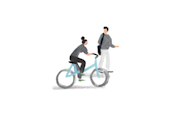How many times have you sat down to watch a movie with a bowlful of popcorn? If the film is pretty good, you might not even notice how much you’re eating, until your fingers scrape the bottom of the empty bowl.
This kind of binge eating is really common. It’s also common to eat until we feel overstuffed on Thanksgiving, or to overindulge at holiday parties, or to plow through a big bag of chips on a long, boring drive.
But sometimes, binge eating is something much more serious.
When does an occasional overindulgence tip over into disordered behavior? What makes a person binge eat? And if a person has trouble with binge eating, how can they stop?
What qualifies as a binge?
The Diagnostic and Statistical Manual of Mental Disorders(DSM-5), the most turned-to handbook for those in the field of psychology, defines a binge of food in two ways:
1. Eating, in a discrete period of time (e.g., within any 2-hour period), an amount of food that is definitely larger than most people would eat in a similar period of time under similar circumstances
2. The sense of lack of control over eating during the episode (e.g., a feeling that one cannot stop eating or control what or how much one is eating)
This definition may be a bit unsatisfying (how do I know how much “most people” eat in two hours?) but the point to focus on here is the element of control—or rather, the lack thereof. Sure, you may eat candy till your teeth hurt on Halloween, but if you feel compelled to overeat, if it feels like a need instead of a want, you might have a problem known as binge-eating disorder, or BED.
What is binge-eating disorder (BED)?
Binge-eating disorder is one of the most common eating disorders, along with anorexia and bulimia. While binging can play a role in all three disorders, at an extremely simplified level, the differences among them are:
Anorexia, which involves an extreme fear of weight gain, is about caloric restriction, with binge eating occurring less frequently
Bulimia is a “binge and purge” disorder, in which people “compensate” after binge eating, (often by forcing themselves to vomit, but also by abusing laxatives or engaging in intense exercise)
People with BED binge, but do not regularly engage in compensating behavior like purging or fasting
What might surprise you is that BED is the most common eating disorder—by far. It’s three times more common than anorexia and bulimia combined,[1] according to the National Eating Disorders Association (NEDA). It’s even more common than breast cancer. BED affects about 3% of Americans, most of whom look like they have a “healthy” body weight or are on the heavier end of the weight spectrum.[2]

What makes a person binge eat?
There are plenty of reasons a person might overeat, one of which is simple boredom. But two of the most common culprits are certain foods and certain moods.
Some foods inspire binge eating
Remember the old Lay’s potato chips slogan: “Bet you can’t eat just one”? Why is that? Is it possible that some foods actually make us more likely to binge?
The short answer: yes.
It’s not a coincidence that processed, high-fat, and high-sugar foods like chips and cookies are more likely to inspire binge eating. The food industry has spent a lot of time and money engineering foods that we want to eat…and eat and eat.
While the subject of clinical food addiction is controversial among both scientists and therapists, some researchers believe our bodies react to certain foods—particularly highly processed foods—in the same way our bodies react to addictive substances like drugs.[3] These foods seem to trigger the brain’s reward response system, the same way addictive drugs do.[4]
You may have noticed that crunchy foods can be particularly bingeable. Strangely enough, sound plays an important role in how much we eat. During one study, researchers muffled some people’s ability to hear the crunch, and those people actually ate less.
It’s imperative to note, however, that restricting any foods—including that which may be “designed” to inspire cravings, correlates directly to bingeing.
Are you an emotional eater?
Of course, we can’t only blame the food for making us eat past the point of fullness; we obviously play a role ourselves. Some folks are particularly likely to overeat when upset. How many movies have you watched where a heartbroken hero polishes off a whole pint of ice cream—or an entire pizza—after a painful breakup?
We use certain foods to comfort ourselves, to self-soothe. Therapists call this “emotional eating.” Most of the rest of us call it “comfort food.”
Often, people are concerned about emotional eating from a weight-gain perspective. But marriage and family therapist Signe Darpinian, who’s a Certified Eating Disorders Specialist (CEDS-S) and President of the Bay Area chapter of the International Association of Eating Disorders Professionals (iaedp), is more concerned about the emotional aspect. She notes we “do” emotional eating to avoid feeling certain emotions, or to avoid dealing with our feelings.
“Emotional eating is problematic because it blocks the emotion. Over time, it can lead to depression,” she says. “Everything you sweep under the rug will still be sitting there, waiting for you on your next bad day."
That’s one reason Darpinian emphasizes the importance of pausing before you eat to check-in, both with what is on your plate and why. Being mindful of the fact that you’re reaching for the cookies because you’re feeling blue gives you a chance to make a different choice. That said, binging is less about which foods you eat and more about eating to the point of discomfort. It’s equally important to check in with yourself while you eat; look for your body’s natural fullness cues.

Psychological and genetic factors
According to NEDA, “No one knows for sure what causes eating disorders.” A range of biological, psychological, and sociocultural factors—like the pressure to be thin—all seem to play a role.
That said, some people may be genetically predisposed to eating disorders, according to the AED. The fact that binge-eating disorder seems to run in families could point to a combination of genetic and environmental influences, like learning from our parents that it’s better to stuff our feelings down with food than to express them.
Trauma is also a significant risk factor for developing an eating disorder, especially if that trauma involved interpersonal violence like sexual assault. Dr. Timothy Breweton, an expert in the field of trauma and eating disorders, says binge eating and purging can be a “coping mechanism” some people use to numb out, reduce anxiety and even block the memories of traumatic experiences. It can’t be stressed too much: B.E.D. is a disordered behavior that serves as a numbing mechanism for other pains or distresses.
How do I know if I have binge-eating disorder?
Many people binge sometimes—or at least engage in emotional or mindless eating—and for some people, this is a clue about certain issues in our relationship with food. But do these behaviors mean we have an actual eating disorder, or that we’re on our way to developing one?
“Unhealthy eating behaviors exist on a continuum,” says the AED. At one end of the spectrum is the occasional mindless or emotional eating binge. Darpinian says these behaviors can be part of “a peaceful relationship with food.” They’re nothing to worry about, and she urges us not to beat ourselves up for binging once in a while.
But at the other end of the spectrum are eating disorders that can be very serious, both psychologically and physically. In some cases, these disorders are fatal. “Eating disorders have the second highest mortality rate of all mental health disorders, surpassed only by opioid addiction,” according to the NEDA.
But can occasional binge eating turn into a full-blown eating disorder? We don’t actually know.
How do you know if you have BED? According to the NEDA:
Binge-eating disorder is characterized by:
recurrent episodes of eating large quantities of food (often very quickly and to the point of discomfort);
a feeling of a loss of control during the binge;
experiencing shame, distress, or guilt afterward;
and not regularly using unhealthy compensatory measures (e.g., purging) to counter the binge eating.
Getting a diagnosis
Unlike anorexia and bulimia, which skew heavily female, about a third of the people diagnosed with binge-eating disorder are male, according to the Columbia Center for Eating Disorders at Columbia University. BED also affects people from all racial and ethnic groups, and in all ages and stages of life.
But unfortunately, people with BED often go undiagnosed unless they specifically ask for help. For starters, many people with BED binge privately—in the car, the bathroom or anyplace else others can’t see them—so friends and family may not realize there’s a problem.
And many people with BED look like they have a perfectly healthy body weight. In fact, Darpinian points out that many people who binge never actually gain weight from overeating.

For those people with BED who are heavier than our society and medical profession deem “normal,” it’s not uncommon for physicians who don’t know about their binging to prescribe weight-loss programs or even diet pills, rather than probing to find out if the weight gain is related to an eating disorder. But a mental disorder cannot be treated as if it were a weight disorder.
That was the experience of Ryan Sheldon, a brawn/plus-size model and eating disorder advocate. At one point, he was spending almost $700 a week on fast food and eating as many as 10,000 calories in a single binge. Ryan says receiving a BED diagnosis helped him release a lot of the shame surrounding his behavior. He has since become a NEDA Ambassador, helping to educate people about eating disorders and body acceptance.
How can I stop binge eating?
You might want to seek out the help of an expert if you have a turbulent relationship with food.
After binge eating, do you feel guilt, shame or distress?
Do you obsess about food?
Do you use food as a comfort when you’re feeling emotionally fragile?
Do you avoid eating in front of other people or do a lot of “secret eating”?
Do you eat really, really fast?
Do you zone out when you’re eating? Are you ever shocked by all the empty food wrappers or dishes in front of you?
If you’re experiencing emotional and/or social distress—including having trouble focusing at work—Darpinian recommends working with a therapist who specializes in eating disorders. She says Certified Eating Disorder Specialists (CEDS) have gone through extensive training, as well as continuing education to stay current on new discoveries in the field and the most effective treatments.
If you find you can’t work with a CEDS, look for a registered dietician with a demonstrated track record of working with people who have eating disorders.
Darpinian helps her clients make peace with food—and with their bodies—and deal with any underlying or unresolved trauma. The process of making peace with food can involve noticing the emotions that trigger non-hungry eating, discovering (then derailing) any habits that lead to binging and learning to trust yourself around food again.
Improving our relationship with food can pay huge dividends. As Darpinian reminds us, “Food is supposed to be social and pleasurable—and fun.”
Hudson, J. I., Hiripi, E., Pope, H. G., & Kessler, R. C. (2007). The Prevalence and Correlates of Eating Disorders in the National Comorbidity Survey Replication. Biological Psychiatry, 61(3), 348–358. https://doi.org/10.1016/j.biopsych.2006.03.040
American Psychiatric Association. (2013). Feeding and Eating Disorders. In Diagnostic and statistical manual of mental disorders (5th ed.). Washington, DC: Author.
Schulte, E. M., Avena, N. M., & Gearhardt, A. N. (2015). Which Foods May Be Addictive? The Roles of Processing, Fat Content, and Glycemic Load. PLOS ONE, 10(2), e0117959. https://doi.org/10.1371/journal.pone.0117959
Alonso-Alonso, M., Woods, S. C., Pelchat, M., Grigson, P. S., Stice, E., Farooqi, S., … Beauchamp, G. K. (2015). Food reward system: current perspectives and future research needs. Nutrition Reviews, 73(5), 296–307. https://doi.org/10.1093/nutrit/nuv002
Alonso-Alonso, M., Woods, S. C., Pelchat, M., Grigson, P. S., Stice, E., Farooqi, S., Khoo, C. S., Mattes, R. D., & Beauchamp, G. K. (2015). Food reward system: Current perspectives and future research needs. Nutrition Reviews, 73(5), 296–307. Retrieved from https://doi.org/10.1093/nutrit/nuv002
Audioboom. (2020). Disrupting habits that don’t help. (2020). Retrieved from https://audioboom.com/posts/7651840-disrupting-habits-that-don-t-help
Berkman, N. D., Brownley, K. A., Peat, C. M., Lohr, K. N., Cullen, K. E., Morgan, L. C., Bann, C. M., Wallace, I. F., & Bulik, C. M. (2015, December 1). Table 1, DSM-IV and DSM-5 diagnostic criteria for binge-eating disorder. Retrieved from https://www.ncbi.nlm.nih.gov/books/NBK338301/table/introduction.t1/
Binge Eating Disorder. (2017, March 15). Retrievedfrom Columbia University Department of Psychiatry website: https://www.columbiapsychiatry.org/research-clinics/eating-disorders-clinic/about-eating-disorders/binge-eating-disorder
Columbia University Department of Psychiatry.(2017, March 15). Binge Eating Disorder. Retrievedfrom https://www.columbiapsychiatry.org/research-clinics/eating-disorders-clinic/about-eating-disorders/binge-eating-disorder
Moss, M. (2013, February 20) The extraordinary science of addictive junk food. The New York Times. Retrieved from https://www.nytimes.com/2013/02/24/magazine/the-extraordinary-science-of-junk-food.html
National Eating Disorders Association. (2014, April 3). Trauma, sexual assault and eating disorders. Retrieved =from https://www.nationaleatingdisorders.org/blog/trauma-sexual-assault-and-eating-disorders
National Eating Disorders Association. (2016, November 23). Our Work. Retrieved from from https://www.nationaleatingdisorders.org/about-us/our-work
National Eating Disorders Association. (2017, February 21). What are Eating Disorders? Retrieved from https://www.nationaleatingdisorders.org/what-are-eating-disorders
National Eating Disorders. (2017, March 21). Other specified feeding or eating disorders. National Eating Disorders Association. Retrieved from https://www.nationaleatingdisorders.org/learn/by-eating-disorder/osfed
Ordabayeva, N., & Srinivasan, R. (2019). The effects of salience of the sound of food on consumption. Appetite, 138, 260–268. Retrieved from https://doi.org/10.1016/j.appet.2019.03.030
Resources - Academy for Eating Disorders. (2020). Retrieved from Aedweb.org website: https://www.aedweb.org/resources/about-eating-disorders/fast-facts
Schulte, E. M., Avena, N. M., & Gearhardt, A. N. (2015). Which foods may be addictive? The roles of processing, fat content, and glycemic load. PLOS ONE, 10(2), e0117959. Retrieved from https://doi.org/10.1371/journal.pone.0117959
Statistics & Research on Eating Disorders. (2018, February 19). Statistics & research on eating disorders. Retrieved rom National Eating Disorders Association website: https://www.nationaleatingdisorders.org/statistics-research-eating-disorders






